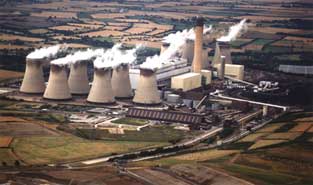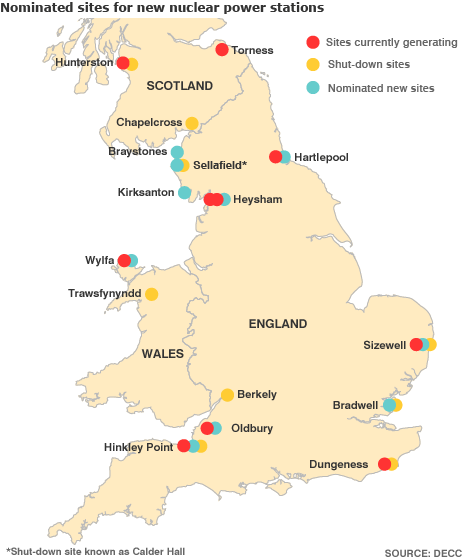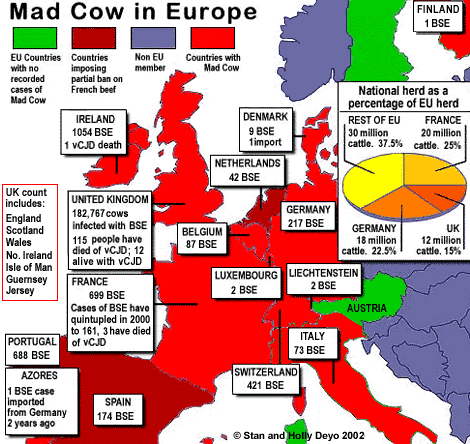Serious Alzheimer's infection agent caused by burning BSE tallow in power stations.





In March 1996, following the BSE fiasco, the Government ordered the slaughter of hundreds of thousands of cattle under the 30 month scheme (OTMS). The resulting carcases were rendered into tallow and stored in bulk tanks and drums all over the UK. Due to the high risk of BSE infection the tallow was banned from use as either a food product or for industrial purposes. Here it sat, hundreds of thousands of tonnes, festering for 8 years, until 2004.
The problem of what to do with potentially BSE infected tallow has been examined by various august bodies, who have rejected land-fill or chemical destruction and have agreed that the only satisfactory and safe method is incineration at high temperature (1000° C). Even at these temperatures the Environment Agency’s own tests confirm that the prion protein responsible for BSE/NvCJD is not necessarily completely destroyed but only the risk of infection is significantly reduced.
The Government, obviously growing weary of paying massive amounts for long-term bulk tank storage, has now decided that certain nominated coal fired power stations will have to burn the BSE infected tallow as a fuel.
On the face of it, this may not seem a bad idea since high temperatures can be achieved in a power station furnace until you understand the principle of using liquid fuel in a coal fired boiler. Under normal circumstances a power station will shut down and re-start on a regular basis according to demand and this may happen several times a day. Gas and oil fired stations achieve this simply by turning the fuel on and off as required. A coal station is a little more difficult as the furnaces have to be brought up to temperature first using heavy fuel oil before the coal can be added, normally by conveyor or blown in as a micronized powder. If you substitute tallow for heavy fuel oil, you are injecting material into a relatively cold environment, which will take some time to increase in temperature to a level where the prion protein is being destroyed or even partially neutralised. During this initial fire-up period the BSE infected tallow is being partly vaporised and ejected from the power station chimney to fall over a wide area. (This is precisely what happened with the “funeral pyres” of BSE infected cattle that were polluting the land at the height of the “BSE crisis”.)
In addition to the potential widespread health risk, there was a serious risk to the power station workers, tanker drivers and bulk storage personnel, who were expected to handle the BSE infected tallow. Were we to expect them to be equipped with full biological protective clothing or were the Government relying on the long incubation period for NvCJD before the full implications are realised ?
In the summer of 1996 National Power and Powergen carried out small scale trials of burning BSE tallow in conjunction with the Environment Agency. The published results stated “At present, no specific analytical technique exists to test for the presence of the BSE prion in any matter. There is no direct method, therefore, of detecting the prion in either emissions or ash.” It goes on to say “…on the advice of SEAC( Spongiform Encephalopathy Advisory Committee) the agency has made the cautious assumption in its risk calculation that the presence of amino acids, albeit in incomplete sequences, might indicate the presence of some infectivity in the final ash”
In areas where biomass fuels are being considered as a “green” power source, some local councils have already refused the concept of using tallow, but I suspect not necessarily for the full reasons given above.
The chilling fact is that the full effect is unlikely to come to light for up to 40 years, long after those culpable have left office or died themselves.
Additional information
As the effect of closing coal-fired power stations is being felt in lack of power capacity (we now produce less power than we need at peak times) some of the older oil fired stations are coming out of moth balls.
These stations still can't run on polluting heavy oil because it is too expensive and consequently are running on tallow or vegetable oil (mainly palm oil from the decimated forest areas)
Forget wind power this is just a political ploy, you need thousands of wind turbines to replace one coal fired station. This is at eye watering cost and also results in the continued death of thousands of birds that fly into the blades. The vibrations from these blades also disrupt communications and cause various medical effects in the people who live nearby.
The UK is on the verge of brown-outs and this situation will only get worse as we wait for new nuclear stations.
Do you have a power station in your area and are you concerned about fall-out ?
Full description of Alzheimers and available treatments
- Alzheimer's - A complete guide to Alzheimer's and associated conditions, together with know
Alzheimer's disease is related to other prion protein diseases in humans and animals. This article examines the relationship between them and advances made in the treatment. The use of essential oils can offer some help as can some herbs and vitamins
© 2012 Peter Geekie





